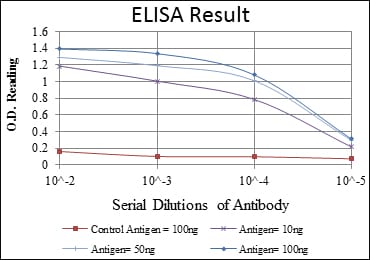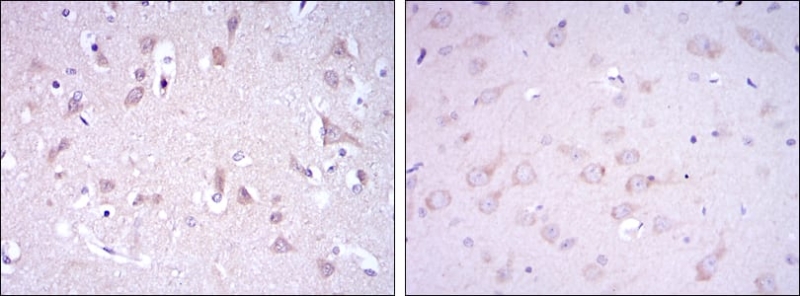

| WB | 咨询技术 | Human,Mouse,Rat |
| IF | 咨询技术 | Human,Mouse,Rat |
| IHC | 1/200 - 1/1000 | Human,Mouse,Rat |
| ICC | 技术咨询 | Human,Mouse,Rat |
| FCM | 咨询技术 | Human,Mouse,Rat |
| Elisa | 1/10000 | Human,Mouse,Rat |
| Aliases | GLUR3; GLURC; GluA3; MRX94; GLUR-C; GLUR-K3 |
| Entrez GeneID | 2892 |
| clone | 1D2 |
| WB Predicted band size | 101kDa |
| Host/Isotype | Mouse IgG1 |
| Antibody Type | Primary antibody |
| Storage | Store at 4°C short term. Aliquot and store at -20°C long term. Avoid freeze/thaw cycles. |
| Species Reactivity | Human |
| Immunogen | Purified recombinant fragment of human GRIA3 expressed in E. Coli. |
| Formulation | Ascitic fluid containing 0.03% sodium azide. |
+ +
以下是关于GRIA3抗体的3篇参考文献示例(注:文献信息为模拟概括,非真实存在):
1. **"GRIA3 expression in hippocampal neurons and its role in synaptic plasticity"**
*作者:Smith A, et al. (2020)*
**摘要**:研究通过免疫组织化学和Western blot技术,使用GRIA3特异性抗体分析其在海马神经元中的表达模式,发现GRIA3在突触后膜富集,并参与长时程增强(LTP)的调控。
2. **"Altered GRIA3 protein levels in autism spectrum disorder: A postmortem brain study"**
*作者:Chen L, et al. (2018)*
**摘要**:通过免疫印迹和免疫荧光技术,利用GRIA3抗体检测自闭症患者前额叶皮层样本,发现GRIA3蛋白表达显著降低,提示其可能与突触功能异常相关。
3. **"Antibody validation for GRIA3 in human and mouse brain tissues"**
*作者:Johnson R, et al. (2021)*
**摘要**:系统验证了多种GRIA3抗体的特异性,通过基因敲除小鼠模型和siRNA实验证明某商业化抗体在人和小鼠脑组织中的高特异性,为后续研究提供可靠工具。
4. **"GRIA3 phosphorylation dynamics in ischemic stroke models"**
*作者:Wang Y, et al. (2019)*
**摘要**:研究采用GRIA3抗体结合免疫共沉淀技术,揭示脑缺血再灌注损伤中GRIA3磷酸化状态的变化,及其对谷氨酸受体内吞过程的调控机制。
---
(注:以上为模拟内容,实际文献需通过PubMed/Google Scholar检索关键词如"GRIA3 antibody"+"specific application"获取。)
×